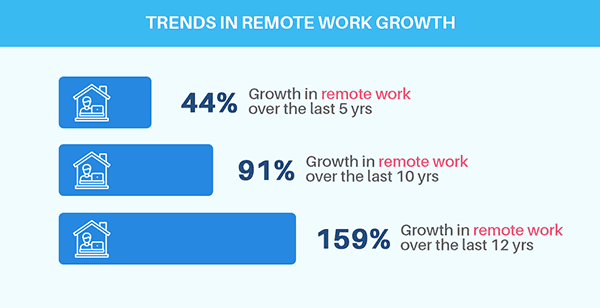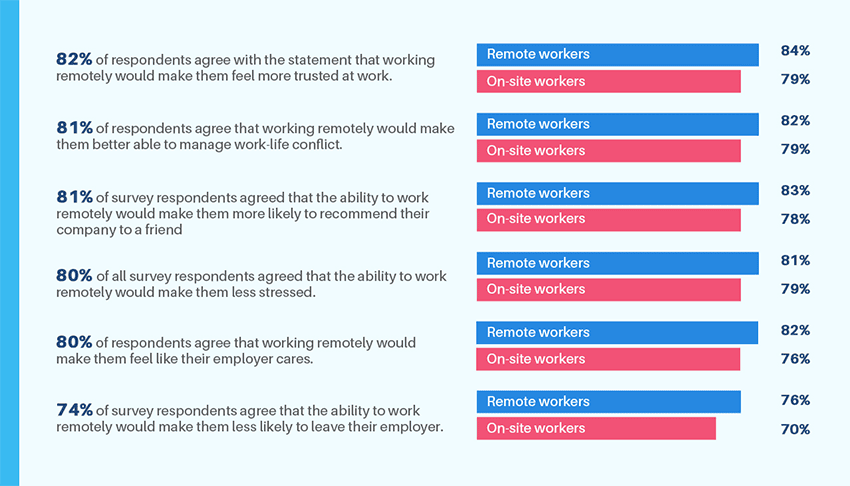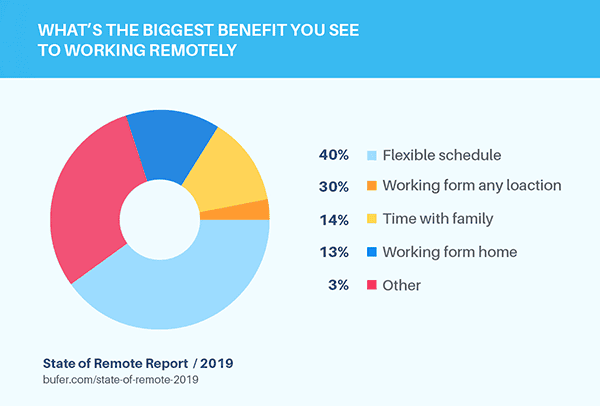10 Crucial Remote Working Statistics You Ought To Know in 2020

Summary – As an employer, remote working may have seemed like just an employment perk and often deemed unnecessary in the past, but today it has grown to bring benefits to your enterprise – if you know the right thing to do! In this blog, we tell you all about it, backed by sufficient proof of how remote working can be a blessing in disguise.
2020 has been a hectic year, to say the least, and we’re in September already! As employers largely relied on remote work out of compulsion because of the lockdown amid the COVID-19 scare, remote working as we knew it to be has been changed in many ways in the lockdown – however, keeping its essence intact. As many small and medium companies struggle in between all the chaos of economic destabilization, it’s because of the advanced digital technology that has ensured that numerous homegrown and large-scale businesses stayed open and made a living.
From innovative, collaborative tools to high-end analytics, understanding the productivity of employees as they work remotely has never been easier for employers. Before the pandemic, brands big and small were adapting to remote working and several studies predicted that it would compete with office locations entirely – but with COVID-19 and delay in the vaccine development it’s already looking like remote working is eliminating office spaces from the industry more by the day. Many businesses report that remote working has improved overall productivity, concentration, as well as kept the employees happier. Here are some of the statistics that support remote working:
In Terms of Remote WorkForce Numbers:
- Census of the Remote Workers – A History
Figures of the remote-working population have grown profoundly in the past few years as the Remote Work Statistics report 2019 says that there has been a rise of 7.9% in a single year (2016-2017), and a staggering rise of 44% in the past half-decade. This is certain to see an even more drastic increase once the report for 2020 is made available.

- Rising Demand for Remote Working – By the Figures
While that’s just a glimpse into the complete workforce, there’s also the staggering numbers of the workforce – accurately, 62% of people work remotely at least some of the time. This means that while some workers work primarily from the office, they often work several days a month from home. Such flexibility is hardly seen in any other form of work setup and therefore is convenient on many terms for single parents, college-going interns, and even to people with limited means or located far away from their company to cut back on travel allowances. And when we say convenience it can mean working from their favorite coffee shops, coworking spaces, libraries, or even from their grandparents’ basement.
- Understanding What People Mean When They Say Remote Office
In the USA itself, about 4.3 million people are remote workers at least 50% of the time, as more and more companies are opening up to remote working options – about a 40% increase from 2013 to 2018. The State of Remote Work 2018 report also suggests that 78% of all remote workers usually mention their study rooms as their home base, and that’s because companies have been offering more remote work opportunities. Why? Because it can cut down up to 25% of labor costs like less sick days and time off, and no additional expenses like investing in coffee machines at your office. The pandemic provided companies that never considered offering remote work a real insight into its benefits, and surely the number of permanent remote working positions will increase drastically.
In Terms of Productivity:
Now that you know the rising popularity of remote working scenarios has been there around for some time, it’s important to learn how it influences the yield of the enterprise. Multiple studies and results have been conducted over time and different organizations to have better insights about the situation. The most meaningfully significant are:

Credits:Owl Labs
- Remote Workers May Get You Higher ROIs
According to a study conducted in AT&T’s workplaces, the telecommunication giant revealed to have pulled in $150 million worth extra-productive hours of work from its employees. If you’re thinking it to be a coincidence, then it would amaze you to learn that under similar circumstances, Cisco also reported a yearly saving of $277 million because of super-productive remote working employees. What was churning such large figures? When dug deeper, it was found that employees thrive under flexibility that comes profoundly with remote working.
The Stanford University conducted study shows that many NASDAQ-enlisted companies showed a performance increase of up to 13% when the workers were given remote working opportunities. It is also important to mention that most of the remote workers added more value compared to the office-goers as they stayed more engaged with their tasks at hand and had higher work satisfaction than others.
- Remote Workers may have Better Privacy and Lesser Distractions
If you’re into the corporate industry, you’d probably know when we talk about distractions in an office space layout. Be it hierarchical stress, or unsupportive team members – employees can feel stifling under such accounts. It can directly impact their workflows, ideation, and creative processes. Researchers from Harvard Business Review found that 75% of employees are more worried about their privacy at the workplace than they were 10 years ago which can lead to serious repercussions for the employers. As a remote worker, employees seem to have a better go at work-life balance than traditional setup, therefore experience an increased sense of focus as they save a lot of concentration from having to get back on track from perpetual machines of distraction in most offices.
- Remote Working Gets You Better Recruits
Millennials and Generation Z are more likely to see themselves working in a place that provides them convenience working. In fact, the annual IWG Global Workspace Survey found out that about one-third of 80% of US workers would not shy away from turning down a prestigious job opportunity if they don’t come with remote working perks. Therefore, it is needless to say that for an organization looking to scale and hire valuable employees, remote working is imperative.
The annual survey conducted by FlexJobs revealed that more than 65% of people self-reported to feel more productive from their home office locations than office spaces for a plethora of reasons like – less exposure, no stressful commute, not worrying or getting distracted by office drama, etc. Instead, many studies surface the fact of remote employees being more satisfied with their job and yield, as well as can even outperform themselves than in their office cubicles. Here’s what certain reports suggest:
In Terms of Employee Experience

Credits:Buffer
- Remote Workers Feel More Satisfied With Their Job
For a developer, it is pretty difficult to maintain a firm work-life balance because of the demanding industry they work in and its rising challenges. The 2017 Stack Overflow report says that 53.3% of such developers experienced higher job satisfaction when they were working entirely remotely. It is because of the remote working flexibility they could squeeze in family time within their hectic work shifts. It is a great motivator for workers who are anxious to resume work given the ongoing pandemic and establishes trust for their employers since it keeps them safe. In fact, the recent Cigna COVID-19 Global Impact study in the UK also found out that the remote-working opportunity has caused the work-stress to drop substantially and encouraged more than 61% of them to take time to learn and hone their skills in their extra time.
- Remote Workers Do Better in terms of Mental and Physical Health
Away from the regular hassle of traveling and indulging in office politics, remote workers say that the positive vibes which job satisfaction brings also induces them feeling valued and stay healthier both physically and mentally. Leading job-search website Indeed conducted a remote work survey that came out with results declaring 56% of workers had less absences and sick days. Working remotely by oneself also gives the employees complete liberty of self-care as they can now see clearly when they need to stretch in work-breaks, make time for meditation or daily morning exercise. It may also add up to having better creativity and agility which may be reflected in their work.
- Remote Workers May Churn Extra Work Hours – Without Feeling it!
The World Health Organization reports a major chunk of money (approximately $1 Trillion every year) is the price that the world has to cough up because of worker productivity loss, eventually leading to mental illness. It may seem like a big problem but the solution lies in simple steps like equipping employees with autonomy, a sustainable work environment, etc. Remote workers simply experience better freedom in terms of their productivity as well as daylight savings from commute time, breaks, etc, to add it back into their days to go beyond the classic 9 to 5 setups.
As Owl Labs’ 2019 report puts it, remote workers have been observed to pull off more than 40 work hours per week, with 43% more frequency than the traditional office-goers who may do so out of compulsion and stress. The difference can be clearly seen in their output – both in terms of value and content.
- Lastly, Remote Workers are More Likely to Stay Long-term
As said before, employees are more engaged when they are working remotely, and for 97% of the employees, such flexibilities, in the long run, help them to decide if they want to switch or stay right back. While salary increases, growth, and other factors finish close seconds, it’s the flexibility that employees prefer in an enterprise. No, it’s not gas-talk, as The New York Times and Thrive Global report that 89% of companies actually witnessed improved employee retention by providing them flexible job opportunities!
What Matters At The End
Accountability from both the parties goes a long way when we talk about remote working – because that’s what pushes a healthful growth for the employee and the employer in a remote work setting. For the employee, it means working honestly when nobody’s watching and for the organization to keep up with the employees’ needs in a more dynamic work setting. It’s a win-win for both as employees feel happier, healthier and generate more value work; while employers save operational costs, and reap sweet profits. Of course, they’d need to upgrade technologically for the entire remote work operation to get on its feet. Tools like Time Doctor, Hubstaff may also help employers to track their employees’ activity and pay them adequately.
There are some downsides to doing all of your remote work from home. In addition to sometimes leading a less healthy lifestyle, some working from home may experience productivity drains depending on what type of home environment they have. It’s not a full time option for everyone.
The shift caused by the pandemic will lead to larger changes even after we’re all able to return to the office. Companies have discovered that it’s far cheaper to have employees work from home, or at least to not own their own office space. Many are already switching to renting out space at coworking facilities for their remote workers to work from at least part time. It’s much cheaper to lease ready to go office seating than it is to lease and furnish office space. This way, companies are able to have more satellite locations closer to remote employees, and still get many of the benefits of having remote workers, including larger talent pools.
If you’re looking for a safe, technologically enabled, coworking space with a thriving community, located at the IT hub of Kolkata, feel free to join us at Zioks.


